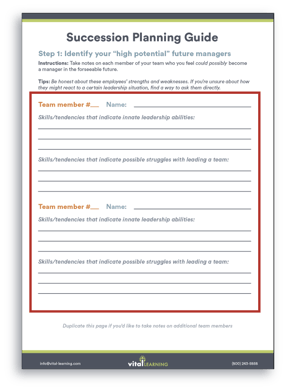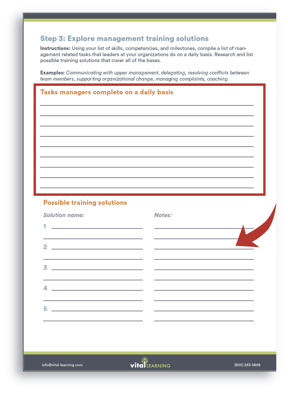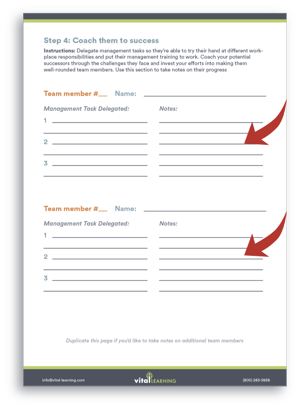 Have you ever promoted someone to be a manager, only to find out that they can hardly even manage themselves?
Have you ever promoted someone to be a manager, only to find out that they can hardly even manage themselves?
This is a common problem across industries, and leads to issues such as disorganization, unmotivated team members, poor workplace communication, and lack of dedication to a common goal. Succession planning is crucial in achieving growth, and ensuring that your management team is the best it can be. Follow along with this guide, to re-vamp the way you promote your high performers.
When it comes time to promote, some leaders run into these issues:
- High performers are great at their job, but not ready to manage
- Promoting someone will leave a gap in the team’s skill-set
- They don’t know how to spot a potential manager
- No one seems “worthy” of a leadership position
With the right succession planning process, each of these issues can be easily avoided.
A great succession planning process can save your organization money, increase employee retention, and create stability amongst your team.
You can reap the benefits of a “strong bench” by downloading this free Succession Planning Template for Managers, and following along with the steps below.

Developing your succession planning process
In order to establish a highly effective succession planning process, there are four basic steps you need to take:
- Identify your “high-potential” future managers
- Create a path for promotion
- Prepare future leaders by providing management training tools
- Coach them through their transition process
1. Identify your “High Potential” future managers
 Take inventory of your team. On page 1 of your Succession Planning Process Template, record notes about each of the team members you’ve identified as possible future managers.
Take inventory of your team. On page 1 of your Succession Planning Process Template, record notes about each of the team members you’ve identified as possible future managers.
What skills and tendencies do they have that demonstrate potential to successfully lead a team?
What would they struggle with in a management position? Reflect on each employee, and be honest about their strengths and weaknesses.
To help you develop this list, here are some attributes to look for in potential managers:
- They are organized and focused in their work
Managing and organizing go hand-in-hand. From hiring and delegating to scheduling meetings and keeping track of performance goals, managers are constantly organizing in some form. Since business leaders tend to be juggling many responsibilities at once, the ability to prioritize tasks and track progress on multiple projects is an essential trait of successful managers. When looking for potential managers during your succession planning process, pay close attention to the manner in which employees complete tasks, and whether or not there is a “method to their madness” in terms of workplace priorities. Organizational skills go a long way in the business world and can directly impact your bottom line, so look for employees who demonstrate the ability to stay organized.
One of the most important facets of being organized as a leader is prioritization and perspective. Lou Holtz, a famous Notre Dame football coach, coined the phrase “what’s important now?” Leaders need to determine what activities and initiatives best align with organizations goals. They must keep themselves and their team focused on these priorities, worrying less about the unimportant aspects of their work. It’s immensely important to have managers who can prioritize efficiently and stay on track in terms of what needs to be done.
- They have strong interpersonal abilities
The capacity to relate to others and build meaningful relationships is common amongst successful managers. Leaders who are cold, unapproachable, or off-putting have a hard time getting people on board with their ideas, and can even discourage employees from following their lead. Having empathy, understanding, and a genuine curiosity about the feelings of others are skills that keep employees happy, and ultimately leads to a motivated workplace.

After all, “Interpersonal skills and communication skills lie at the center of human-based managerial considerations.” And people naturally gravitate towards those with these qualities. When considering a team member for a management position, gauge how they interact with you, other employees, as well as other higher-ups in the organization. If they seem difficult to keep a conversation with and cannot relate well to others, they may not be the best choice for promotion. A major facet of succession planning is picturing employees in situations they’d face as a leader, and determining their natural ability to navigate them.
- They are Effective Communicators
Management is all about communication. If messages aren’t presented clearly and concisely, they often fall flat in the eyes (well ears technically) of the audience.
If that audience is your workforce, and the message pertains to your growth and organizational success, then having a good messenger is crucial. From keeping employees engaged, to effectively coaching job skills, good communication goes a long way. Here are some things to look for when determining whether or not a team member has the communication skills needed to excel as a manager:
- They have effective nonverbal communication skills
- They seem to be open and honest in their interactions
- They possess good listening skills and listen actively
- They communicate their ideas in an organized manner with a singular, obvious message
Though effective communication is important, exactly what is communicated is critical as well. When analyzing how a team member communicates, remember to pay close attention to what they are communicating. Are they expressing interest in taking the reins on certain projects, and following through with their commitments? This might be another sign that they are a good fit for a future promotion to manager.
- They show initiative and take action
 Commitment is contagious. Motivated managers are able to inspire their employees to reach goals, and keep momentum when goings get tough. Employees who practice commitment to their work as opposed to compliance are far more likely to act as a beacon for motivation for those around them, and make far better managers than those who simply “show up.”
Commitment is contagious. Motivated managers are able to inspire their employees to reach goals, and keep momentum when goings get tough. Employees who practice commitment to their work as opposed to compliance are far more likely to act as a beacon for motivation for those around them, and make far better managers than those who simply “show up.”
Some people find this difficult, but there are many ways to demonstrate initiative as a team member, and doing so helps that employee stand out. When a difficult task is put in front of team members at your organization, analyze who gets discouraged, and who accepts the challenge. If an employee is afraid to take control of situations that are put in front of them, they might not be prepared for the overload of responsibilities that come with being a manager.
- They are gritty
The difficulties that a manager can face on a daily basis cannot be understated. Overseeing multiple people with different needs and motivations can be extremely stressful, and can take a toll on managers who are unable to overcome adversity. Grit is essentially the ability to take these difficulties with stride, and find solutions to issues as opposed to succumbing to them. Angela Duckworth, a leading researcher on the concept of grit states that, “the first thing managers should understand is that people who are gritty will doggedly pursue things that they really value.” This means that those who truly value their work and have the tenacity to ensure the outcome is successful are more likely to be good managers. Letting issues pile up and not responding effectively to adversity can be a sign that a team member is not fit to lead, and might need more time to develop before they are considered.
Something else that ties into the concept of grit is the ability to take feedback, and improve from it. Someone without grit may get discouraged by failure or feedback and never get better. A great potential manager is someone who is able to take feedback into consideration, and improve themselves through deliberate practice and self-reflection.
2. Create a path for promotion

Once you’ve identified your future leaders, you need to start planning. Create a path for upcoming leaders to follow. What are some of the abilities your team members need to polish before they climb the corporate ladder?
 On page 2 of the Succession Planning Process Template, develop a skills checklist to give your future leaders concrete goals to work toward.
On page 2 of the Succession Planning Process Template, develop a skills checklist to give your future leaders concrete goals to work toward.
To be qualified to move to the next level, what milestones should your team members achieve? For example, if your managers regularly use a specific software at your company, include software proficiency in your succession planning checklist.
When team members know that there is a plan for their future, they’re more likely to stick with your company, making it easier to retain the employees you value.
3. Prepare future leaders by providing management training tools
You’ve identified the future leaders of your company and set goals to help them prepare to move up. Now, provide management training to get your team members ready to take the reins.
 Start thinking about what managers at your organization do on a daily basis. On page 3 of the Succession Planning Process Template, write down these tasks. Here are some ideas:
Start thinking about what managers at your organization do on a daily basis. On page 3 of the Succession Planning Process Template, write down these tasks. Here are some ideas:
- Communicating with upper management
- Delegating
- Resolving conflicts between team members
- Supporting organizational change
- Managing complaints effectively
- Coaching and supporting their team
After identifying these competencies, start researching possible training solutions that fit the bill and list them at the bottom of the page.
Choose the solution that you feel will have the most impact on the effectiveness of your current and future managers. Keep in mind that each organization is different, and that a good management training program should be flexible, and built with today’s leader in mind.
4. Coach them to success
 You have all of the pieces to your succession planning puzzle. Now, put them together. Give your future leaders real-world experience and coach them through this professional development.
You have all of the pieces to your succession planning puzzle. Now, put them together. Give your future leaders real-world experience and coach them through this professional development.
Delegate management tasks so they’re able to try their hand at different workplace responsibilities and put their management training to work. Coach your potential successors through the challenges they face and invest your efforts into making them well-rounded team members.
Make sure to only delegate tasks that don’t need to be done by you. Check out our Delegating Guide for Managers to help determine these activities.
On page 4 of the Succession Planning Process Template, we’ve provided an area for you to take notes on the progress of each potential leader. Use this section to reflect on how they’ve improved throughout your coaching process, or if they’re still a candidate to become a manager in the future.
Signs that your succession planning process is working
 There’s no point in developing a succession plan if it doesn’t drive results. After you’ve promoted a few employees, take a step back and analyze the effectiveness of your succession planning process. Here are some questions to ask yourself to determine whether or not your plan is a success:
There’s no point in developing a succession plan if it doesn’t drive results. After you’ve promoted a few employees, take a step back and analyze the effectiveness of your succession planning process. Here are some questions to ask yourself to determine whether or not your plan is a success:
- Are these new managers confident and effective in their role?
- Are the team turnover rates of these managers lower than others?
- Have these new managers achieved high-performing teams?
- Do employees understand what it takes to become a leader at the organization?
- Am I able to more easily spot high-potential future managers?
If you answered “no” to one or more of these questions, there may be some tweaks you can make to your succession planning process.
If you answered “yes” to all of these questions, then congratulations! You’ve successfully created a basic succession plan and should continue to use and enhance this process.
Always remember that humans are humans, not machines. Even the best succession planning process can produce some “bad” managers. The likelihood of this occurring, however, is lowered substantially with a thoughtful and thorough approach to promoting employees to management positions. Take your time in developing your succession planning process, and watch as your employees become happier, your workplace culture improves, and the productivity of your team increases.



